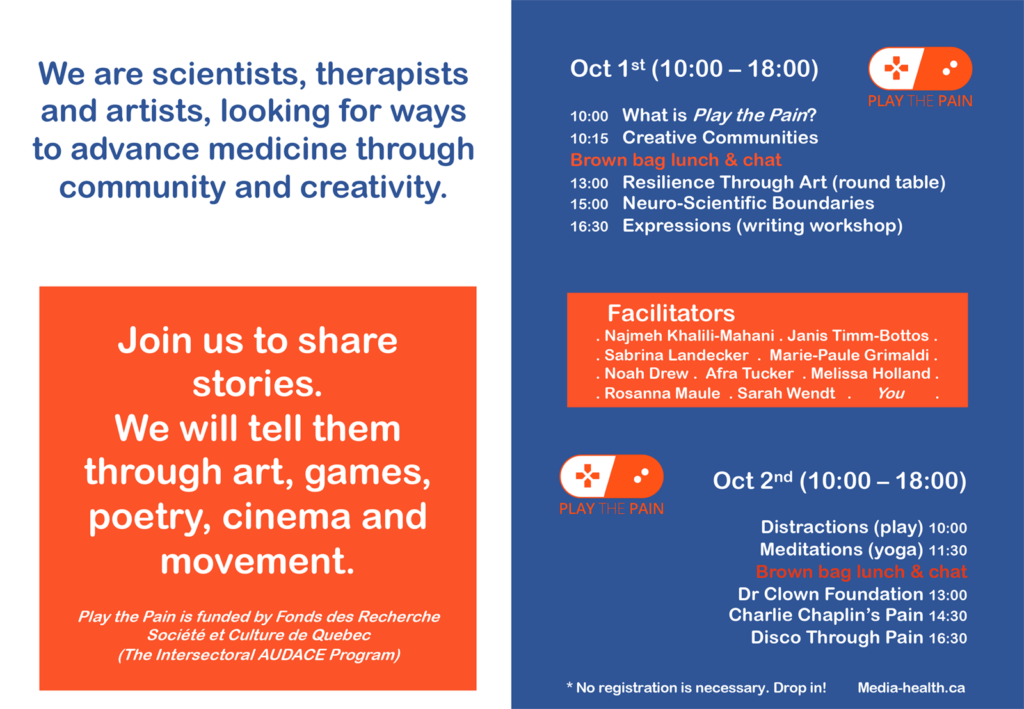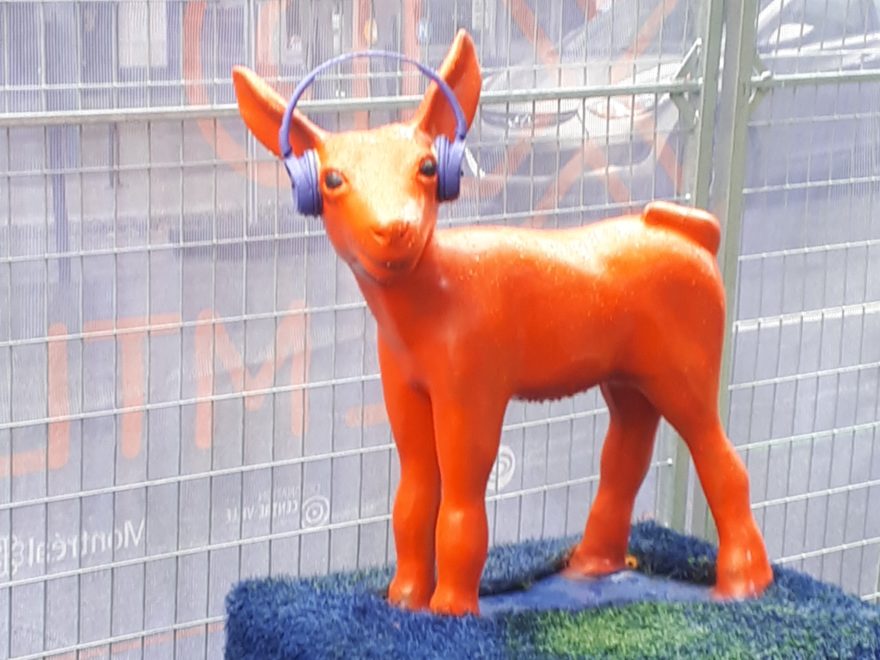Earlier this week I participated in a two-day event, called Play the Pain(1). It combined scientific presentations, discussion periods, and workshops, all relating to the concept of “play” as a tool to aid in the management of chronic pain.
Organized by one researcher in particular, the other attendees included artists, graduate students from both the arts and sciences, other researchers, and a few patients – including me.
The concept was to create a forum, open to the public, at which we could learn from each other; patients could hear directly from researchers about what’s new in the study of chronic pain, and researchers would be able to interact with patients who live with a variety of different pain conditions.
Because hearing any one patient’s perspective is just that – it’s the viewpoint of one particular individual, in a specific set of circumstances. From my bioethics background, I’ve learned that it’s simply not enough to have only one patient representative on any committee or group which is meant to express the views of a larger patient population.
Rather than posting about the individual presentations, sessions, and workshops in the order in which they took place during Play the Pain, I’m going to blog first about the ones on which I took the most notes!
The last session of the first day of Play the Pain was a creative writing workshop, entitled “Expressions: Words that Relate”, weaving our words around the theme of chronic pain. This intense, thought-provoking, and highly personalized workshop was led by a local poet, Marie-Paule Grimaldi:
a writer and activist/artist, whose social and hybrid work extends to women in homeless shelters and prisons…(2)
she creates space for encounters through performance and improvisation within collective shows and public installations or workshops.”(1)
The first activity that Marie-Paule had us complete, individually, was to choose two words. One word representing a part of our body, another for a place we’d like to be.
Looking back on it, this was an efficient – and subtle – means to tease out our specific areas of chronic pain. It was also an excellent way to pique our interest at a particularly low ebb in the event; this workshop took place from 16:30 to 18:00 (or 4:30 to 6:00 PM). I was exhausted by this point, but opted to stay for this session.
My rare autoimmune and neuro-inflammatory disease affects my right hand and arm, so I chose ‘hand’ as my first word. For the second, I went with ‘nature’. It’s a therapeutic environment for me, the great outdoors. The beauty, the grandeur, even the scents and sounds of nature have always comforted me. Maybe because my last name is Woods ‘-)
Once we’d each selected our two words, Marie-Paule asked that we then create a phrase combining them. We had only a moment to try to fashion an image, with words, to share with the workshop participants. I came up with:
Nature flows through my hand”
I imagined an image of my arm with vines for veins, flowers and leaves sprouting off of them. Out of the tips of my fingers, flowers would unfurl. Not roses, but rather wildflowers. It was an image that, in my mind, represented healing and recovery.
The next step in this creative writing exercise was collaborative. Marie-Paule asked that we each think of a word which we associate with chronic pain, and then write it onto a scrap of paper.
I’m right-handed, and Complex Regional Pain Syndrome (CRPS) has rendered that hand more or less unusable. This means that it’s very difficult for me to handwrite anything, so I typed the word into my phone and then asked another participant to transcribe it onto the slip of paper for me.
The word I selected was ‘hope’. These slips of paper, each bearing the chosen word one of the workshop participants, were placed into a box. From that box we then each selected a word; someone else’s view of chronic pain. The word I pulled out of the box, like a magician’s rabbit, was ‘stress’.
To complete this creative activity, we each had to write a very short poem; a few lines, incorporating all four of the words. Again, we read our words to the group – if we wanted to.
Here’s what I came up with, for the three words that I had chosen along with the one I’d pulled out of the box; hand, nature hope, and stress. I built on the image that had stayed in my mind, of plants growing through – and out of – my hand:
Nature flows
through my hand.
Its peacefulness extinguishes
the flames of stress,
transmuting them to rays of hope.”
It’s corny, I know! In my defence, we only had a few minutes! ,-) Some of the others came up with stunning imagery and poetry.
Next we played a type of word-association game. The first challenge was to define the word ‘home’. My definition was “A place of love, comfort, and sanctuary, and wherever my sweetheart is with me… even a forest”.
Next, Marie-Paule asked us each to define the word ‘soft’. My first idea was “a baby bunny in my hands”, because we see a lot of wild rabbits in our back yard ,-) I settled for “the warm feeling from the presence, touch, or voice of a loved one”.
To define ‘help’ I chose “giving comfort”. For ‘power’, I opted for a lengthier definition: “The ability and capacity to change something for someone, even for yourself”.
The last word that we each had to define brought us back to the theme of the event; ‘pain’. My definition was, I think, the longest one:
Arcs of electrical current running through my nerves, with flames shooting out of my fingertips
It can be life-saving and temporary or permanent and life-changing.”
The next exercise was to try our hands at a creative writing challenge. Marie-Paule asked that we each create a character in our minds, and jot down a few lines about them. It could be a real person, but with an original twist. Of course, I did this by tapping into my phone…
I selected the ancient philosopher Socrates, but reincarnated him as a modern woman; a bus driver in a large metropolitan area.
There was another exchange of words, among workshop participants, using slips of paper and the same box. This time we each wrote down a word or phrase for something that could cause pain, and also named a part of the body. My words were ‘fire’ and ‘hand’.
The words I received were ‘glass shards’ and ‘foot’. Marie-Paule then assigned each of us a slip of paper, each bearing images from different famous paintings depicting pain. Each image included a rating of pain severity, from one to ten.
On each of these scraps of paper there was also another word, a descriptor for pain or treatment. The piece of paper that I pulled out of this box showed “Pain level 8 – Courbet” and “Morphine”.
Using the two words we’d each received, we then wrote an extremely short story or poem involving the character we’d imagined earlier. We also had to incorporate into out stories the other two words we’d each drawn out of the box at the start of the exercise; words written by another participant. As a reminder, the ones I’d drawn were ‘glass shards’ and ‘foot’.
We had only five minutes, so our stories were extremely short. Some of the participants’ stories were absolutely fantastic, even in such a short time. This is what I came up with:
The glass shard in her foot
feel as though it has
burrowed into her bones,
creating pain that even
morphine cooks not relieve.
Each time her foot touches
the pedal of her bus,
the pain explodes into
incandescent, burning
explosions of sensation.
Why?
She asks, in true Socratic method.
What can be done?”
Rereading it now, it doesn’t seem to make much sense; I suppose it did – in the moment. Regardless, this was my favourite of all the workshops during Play the Pain.
As always, thanks for reading! Feel free to reach out via Instagram or Twitter; I’ve had to disable comments on the blog as it was being spammed to the tune of 100s of comments per day… too much for me to deal with given that I’m already struggling to blog despite cognitive issues!
Stay tuned for more about Play the Pain…
References
(1) http://media-health.ca/events/play-the-pain-4thspace/
(2) https://m.facebook.com/Marie-Paule-Grimaldi-Map-Gri-292008657874848/


